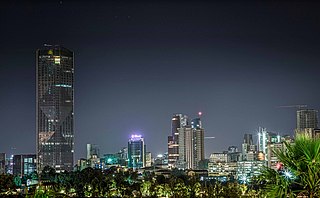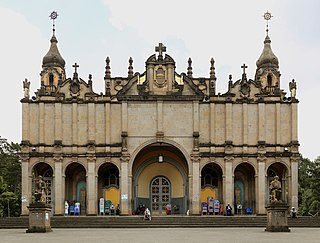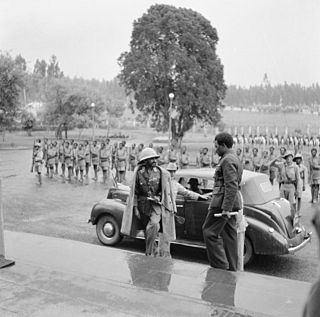
Haile Selassie I was the Emperor of Ethiopia from 1930 to 1974. He rose to power as the Regent Plenipotentiary of Ethiopia under Empress Zewditu between 1916 and 1930. Widely considered to be a defining figure in modern Ethiopian history, he is accorded divine importance in Rastafari, a relatively new Abrahamic religion that emerged in the Colony of Jamaica in the 1930s. A few years before he began his reign over the Ethiopian Empire, Selassie defeated Ethiopian army commander Ras Gugsa Welle Bitul, who was the nephew of Empress Taytu Betul, during the Battle of Anchem. He belonged to the Solomonic dynasty, which was founded by Emperor Yekuno Amlak in 1270; Amlak's successors claimed that he was a lineal descendant of Menelik I, the legendary Emperor of Ethiopia who was supposedly born to King Solomon and Queen Makeda of the Kingdom of Israel and the Kingdom of Sheba, respectively.

Addis Ababa is the capital and largest city of Ethiopia. In the 2007 census, the city's population was estimated to be 2,739,551 inhabitants. Addis Ababa is a highly developed and important cultural, artistic, financial and administrative center of Ethiopia. It is widely known as one of Africa's major capitals.

Lij Iyasu was the designated Emperor of Ethiopia from 1913 to 1916. His baptismal name was Kifle Yaqob. Ethiopian emperors traditionally chose their regnal name on the day they were crowned, and since he was never crowned, he is usually referred to as Lij Iyasu, "Lij" meaning child, especially one born of royal blood.

Zewditu was Empress of Ethiopia from 1916 until her death in 1930. The first female head of an internationally recognized country in Africa in the 19th and 20th centuries, and the first and only empress regnant of the Ethiopian Empire, her reign was noted for the reforms of her Regent and designated heir Ras Tafari Makonnen, about which she was at best ambivalent and often stridently opposed, due to her staunch conservatism and strong religious devotion. She is the most recent empress regnant, as well as the last female Ethiopian head of state until the 2018 election of Sahle-Work Zewde as president.

The prime minister of Ethiopia is the head of government and chief executive of Ethiopia. Ethiopia is a parliamentary republic with a prime minister as head of the government and the commander-in-chief of the Ethiopian Armed Forces. The prime minister is the most powerful political figure in Ethiopian politics. The official residence of the prime minister is the Menelik Palace in Addis Ababa. The prime minister is elected from the members of the House of Peoples' Representatives and presents a government platform. The prime minister must receive a vote of confidence in the House of Peoples' Representatives to exercise executive power as chief executive. Abiy Ahmed is the third prime minister of the Federal Democratic Republic of Ethiopia, serving since April 2018.
Addis Alem also known as Ejere (Oromo: Ejjeree, officially known as Ejere is a town in central Ethiopia. Located in the West Shewa Zone of the Oromia Region, west of Addis Ababa, this town has a latitude and longitude of 9°2′N38°24′E with an elevation of about 2360 meters above sea level.

Until the end of the Ethiopian monarchy in 1974, there were two categories of nobility in Ethiopia and Eritrea. The Mesafint, the hereditary royal nobility, formed the upper echelon of the ruling class. The Mekwanint were the appointed nobles, often of humble birth, who formed the bulk of the aristocracy. Until the 20th century, the most powerful people at court were generally members of the Mekwanint appointed by the monarch, while regionally, the Mesafint enjoyed greater influence and power. Emperor Haile Selassie greatly curtailed the power of the Mesafint to the benefit of the Mekwanint, who by then were essentially coterminous with the Ethiopian government.
Princess Sophia Desta was the youngest daughter of Ras Desta Damtew and Princess Tenagnework Haile Selassie, and granddaughter of Emperor Haile Selassie I of Ethiopia. She was educated at Clarendon School for Girls in the United Kingdom together with her three sisters, Aida, Hirut Desta (Ruth) and Sebel. Princess Sophia was imprisoned, mistreated and humiliated in the Alem Bekagn Kerchele prison, Addis Ababa together with her sisters, other princesses of the Imperial Family, from 1974 until 1988.
Articles related to Ethiopia include:

Mengistu Neway was an Ethiopian commander of the Imperial Guard during the reign of Emperor Haile Selassie. He is noted for being one of the early dissidents of the Emperor's regime and for organizing the 1960 coup attempt with his younger brother Germame Neway, for which he was sentenced to death.

Holy Trinity Cathedral, also known in Amharic as Kidist Selassie, is the highest ranking Ethiopian Orthodox Tewahedo cathedral in Addis Ababa, Ethiopia. It was built to commemorate the Ethiopian victory over Italian occupation and is an important place of worship in Ethiopia, alongside other cathedrals such as the Church of Our Lady Mary of Zion in Axum.

The history of Addis Ababa, capital of Ethiopia, formally begins with the founding of the city in the 19th century by Ethiopian Emperor Menelik II and his wife Empress Taytu Betul. In its first years the city was more like a military encampment than a town. The central focus was the emperor’s palace, which was surrounded by the dwellings of his troops and of his innumerable retainers. In the 1920s, Addis Ababa experienced a significant economic upturn, marked by a surge in the number of middle-class-owned buildings, including stone houses furnished with imported European furniture. The middle class also introduced newly manufactured automobiles and expanded banking institutions. Urbanization and modernization persisted during the Italian occupation, guided by a masterplan aimed at transforming Addis Ababa into a more "colonial" city, a trajectory that continued beyond the occupation. Subsequent master plans, formulated from the 1940s onward with the input of European consultants, focused on the development of monuments, civic structures, satellite cities, and the inner city.

Meskel Square is a public square in the city of Addis Ababa, Ethiopia. It is often a site for Ethiopian Orthodox Tewahedo Church gatherings or for demonstrations and festivals, notably, the Meskel Festival from which it takes its name.

The 1928 Ethiopian coup d'état attempt was orchestrated by supporters of Empress Zewditu to rid her of the heir apparent and Crown Prince, Ras Tafari Makonnen. With Tafari gone, Zewditu would be the sole ruler of the Ethiopian Empire.
Mehal Sefari was the Ethiopian title for the specialized units of the imperial guard during the reign of Emperor Menelik II. The unit grew from Menelik's personal Guard, though oral histories link it to the elite fighting unit of Atse Tewodros II under Fitawrari Gebrye. As Gebrye's military unit was among the last that remained loyal to Tewodros when most of his army left, the assumption is not unreasonable if not conclusive. The title "Mehal Sefari" however was not used by any of Tewodros' units, nor by any other previous military unit. The title translates to "center campers" and alludes to the location the unit encamped in Menelik's expeditionary encampments. Some have also suggested that the unit was used to come between (mehal) battling armies of the nobility. There is however little in way of evidence to demonstrate this as the nobility rarely fought without permission from the Emperor.

Bitwoded Sultan Alimirah Hanfare was Sultan of Aussa from 1944 until his death in 2011. He ascended to the throne after his predecessor and uncle, Mohammad Yayyo.

The National Palace, formerly Jubilee Palace, is a palace in Addis Ababa, Ethiopia. It is an official residence of President of Ethiopia since the Derg government.

LijSeifu Mikael was an Ethiopian royal, member of the Solomonic dynasty from the House of Solomon that descended from the ancient Kingdom of Aksum, belonging to the branch of the aristocratic Amhara family from Ankober Shewa. He was the great-grandson of King Sahle Selassie of Shewa and his wife Queen Bezabish Dejene of Gojjam through his grandfather, Dejazmatch Mekuria Tesfaye of Gerim Gabriel, a first cousin of Emperor Menelik II of Ethiopia.
Alem Bekagn, or 'Kerchele Prison', was a central prison in Ethiopia until 2004. Located in Addis Ababa, the prison possibly existed as early as 1923, under the reign of Empress Zewditu, but became notorious after Second Italo-Ethiopian War as the site where Ethiopian intellectuals were detained and killed by Italian Fascists in the Yekatit 12 massacre. After the restoration of Emperor Haile Selassie, the prison remained in use to house Eritrean nationalists and those involved in the Woyane rebellion. Under the Communist Derg regime that followed, the prison was the site of another mass killing, the Massacre of the Sixty, and of the torture and execution of rival groups in the Red Terror. The prison remained a site of human rights abuses until the Ethiopian People’s Revolutionary Democratic Front entered Addis Ababa on 28 May 1991, after which it became a normal prison. The prison was closed in 2004 and demolished in 2007 to allow the construction of the headquarters of the African Union.

On 17 February 1992, the Ethiopian Radio announced the discovery of the remains of the Ethiopian Emperor Haile Selassie beneath his office in National Palace by workmen. The discovery happened nearly one year after the former military government Derg collapsed in 1991, and under the interim government led by the Ethiopian People's Revolutionary Democratic Front (EPRDF).



















